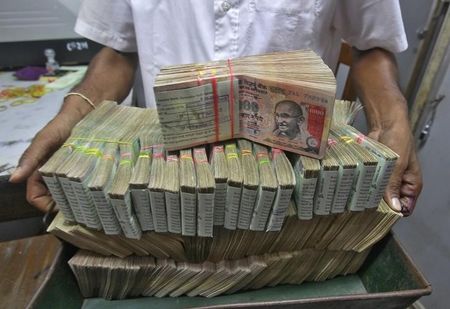
The Indian Rupee (INR) has been under the vigilant watch of the Reserve Bank of India (RBI), which has been focused on maintaining stability and curbing volatility. This strategy, while effective in the short term, has its complexities and potential long-term consequences.
The RBI’s unwavering commitment to keeping the INR stable has been a cornerstone of its monetary policy. By limiting the impact of external factors such as portfolio flows and changes in economic outlook, the RBI has successfully kept the INR in check. This low-volatility environment helps improve the currency’s carry profile, allowing for a narrower interest-rate buffer and reducing the need for hedging foreign exchange risks, despite the low cost of doing so.
Summer Sale: Unlock the power of InvestingPro for unparalleled stock analysis. Discover high-quality dividend, growth, momentum, value stocks, gain insights into top investors’ portfolios, and access our advanced intrinsic value calculations. Click here and subscribe now for a mouth-watering discount of 31%!
However, this prolonged period of low volatility could hinder market price discovery and create a backlog of hedging demand when the volatility regime eventually shifts. Moreover, the RBI’s strategy of building up foreign exchange reserves by absorbing capital inflows might lead to a gradual depreciation of the INR over time.
The continued low volatility in the INR is a direct result of the RBI’s efforts to maintain stability. By containing FX volatility spikes, the RBI aims to decouple its monetary policy decisions from external influences. This policy has successfully kept portfolio flows into India largely unhedged, despite historically low hedging costs.
However, this stability comes with its own set of challenges. The RBI may have overreached in its efforts to control volatility, driving it to levels comparable to those of a pegged currency. Prolonged low volatility can hinder price discovery for the INR and create pent-up hedging demand. Furthermore, a gradual shift in the USD/INR trading range has made it difficult for the market to capture significant carry pick-ups, as the lack of correlation with macro fundamentals persists.
One of the RBI’s consistent policies has been the aggressive build-up of foreign exchange reserves. This strategy is aimed at creating a buffer against future capital outflows. While the RBI has been defending the INR against weakness, the risks of a policy shift are increasing. The need to unwind short forward positions built up while defending the INR around the 83.5/USD level could further skew risks towards gradual depreciation, making the USD/INR pair more likely to follow a buy-on-dip strategy.
To understand the RBI’s intervention patterns, an analysis of key factors over the past decade reveals that the RBI’s highest sensitivity is to portfolio flows, with almost one-to-one absorption of inflows into reserves. This consistent correlation with portfolio flows is partly due to the broader relationship between USD movements and portfolio flows into emerging markets.
Another consideration is the INR’s competitiveness, particularly in promoting domestic manufacturing and import substitution. Recent fluctuations in the trade balance, driven by higher oil prices and wider deficits, have shown a higher correlation with USD strength. The Real Effective Exchange Rate (REER) index for the INR has remained range-bound over the last decade, though it is currently near the top end of this range. While long-term REER appreciation can be justified by productivity gains, further appreciation may be undesirable from a policy perspective.
The RBI’s meticulous management of the INR has helped maintain stability, but it also brings challenges. As the RBI continues to build its FX reserves and navigate the complexities of maintaining low volatility, the potential for gradual depreciation of the INR remains a key consideration. This balancing act will be crucial in shaping the future of India’s monetary policy and the INR’s trajectory in the global market.
Now’s the perfect time to seize the opportunity! For a limited time, InvestingPro is available at an irresistible discount of 31%. Click here and don’t miss out on this exclusive offer to unlock the full potential of your portfolio with InvestingPro.
X (formerly, Twitter) – Aayush Khanna
This post is originally published on INVESTING.



